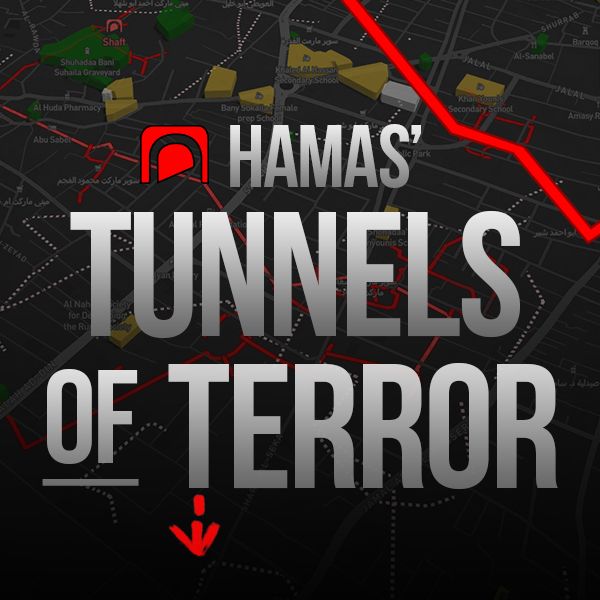Key Takeaways:
-
The photographer behind Gaza “flood” images, Abed Rahim Khatib, was documented inside Israel with Hamas on October 7, raising serious questions about the credibility and intent of his widely circulated photos.
-
Each image selectively frames shallow puddles as “flooding,” using children, tight angles, and deliberate cropping to create an emotional narrative that contradicts the clearly dry surroundings.
-
Across eight cases, captions and imagery systematically exaggerate hardship while omitting key facts—warm weather, dry ground, and Hamas-built tunnel infrastructure—revealing a coordinated effort to manufacture a global sympathy narrative rather than document reality.
In mid-November, Israel and the Gaza Strip experienced the first rains of the season as the region was hit by a torrential downpour. This type of weather is not unusual for the time of year, and both Israeli and Palestinian cities suffer from flooding as drainage systems struggle to cope.
Unsurprisingly, the flooding in Gaza became an international story weaponized to blame Israel.
2/
Gaza has suffered flooding numerous times before. In 2013, Hamas claimed that Israel had flooded parts of Gaza by opening its southern dams.The only problem? There are no dams in the south of Israel.https://t.co/1mWkV5QhyC
— HonestReporting (@HonestReporting) November 17, 2025
Let’s take a look at the photography behind this year’s Gaza flood through the lens of one photographer to demonstrate how images are manipulated to produce an emotional reaction that the reality doesn’t always mirror.
Context: The Photographer Behind the Lens
Understanding the identity and history of the photographer is essential for interpreting the flood images.
Abed Rahim Khatib whose work is distributed by Anadolu, AP, and Getty, is documented photographing inside Israel on the morning of October 7, 2023, at the breached border fence near destroyed IDF positions. These images confirm that he entered Israel alongside Hamas attackers in the first wave of the massacre and was present at active abduction and murder sites.
This is not a small detail. It establishes that the same individual who photographed morgue scenes, hospital scenes, hostage transfer events, rubble, and now rainstorm puddles was physically part of the invasion footprint inside Israel.
It is also relevant that Khatib works for Anadolu. Anadolu is a Turkish state-run news agency that operates with a consistent anti-Israel narrative and is a central distributor of Gaza-sourced imagery to international outlets. This institutional context matters.
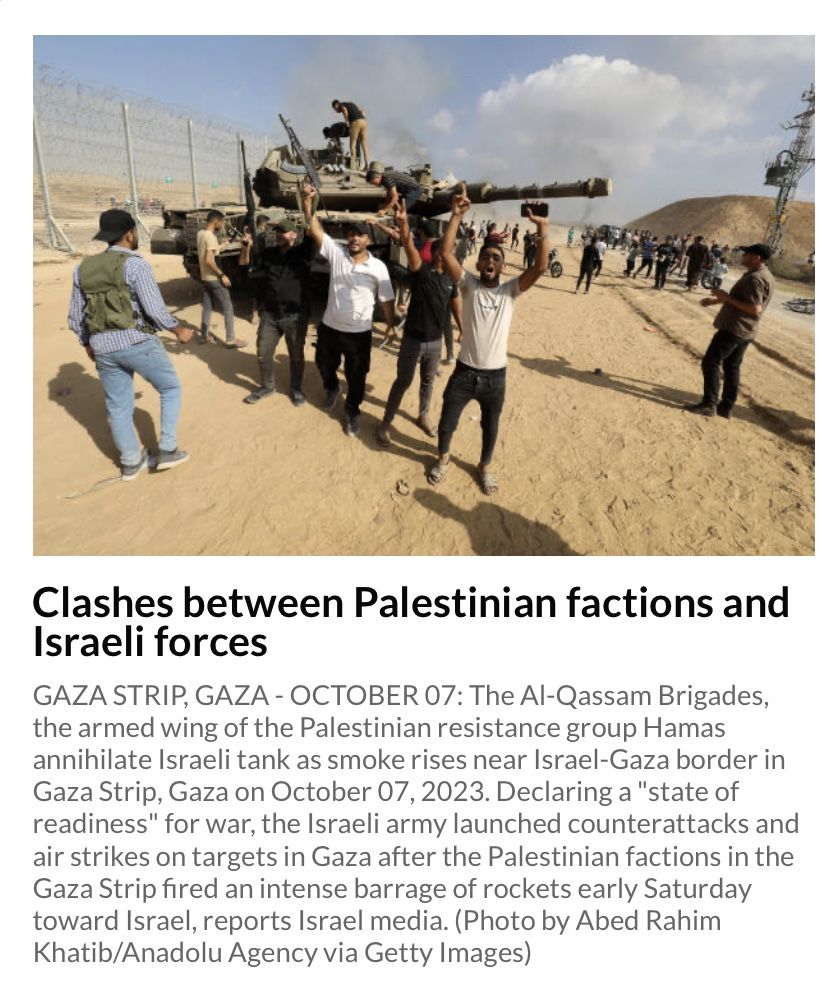


Above: Images taken by Gaza-based photographer Abed Rahim Khatib inside Israel on the morning of October 7 at the breached border fence and destroyed IDF positions. His presence confirms direct access during the Hamas infiltration.
⸻
1.
Forensic Analysis
A child cycles through an ankle-deep puddle. The caption claims heavy rain and cold weather, yet the sky is clear, and the conditions were approximately 25 degrees Celsius (77 degrees Fahrenheit). Two white cars in the background are parked entirely on dry ground. Multiple pedestrians stand or walk on dry concrete a few metres behind the child.
The photographer shoots from a lowered angle, pointing slightly upward. This compresses the foreground water and heightens the emotional weight of the child. A higher or neutral vantage point would immediately reveal the dry horizon.
From a technical standpoint, riding a bicycle through water is unusual. Water of this depth would damage pedals, chains and bearings. In a place with limited access to replacement parts, a child would realistically walk and carry the bicycle.
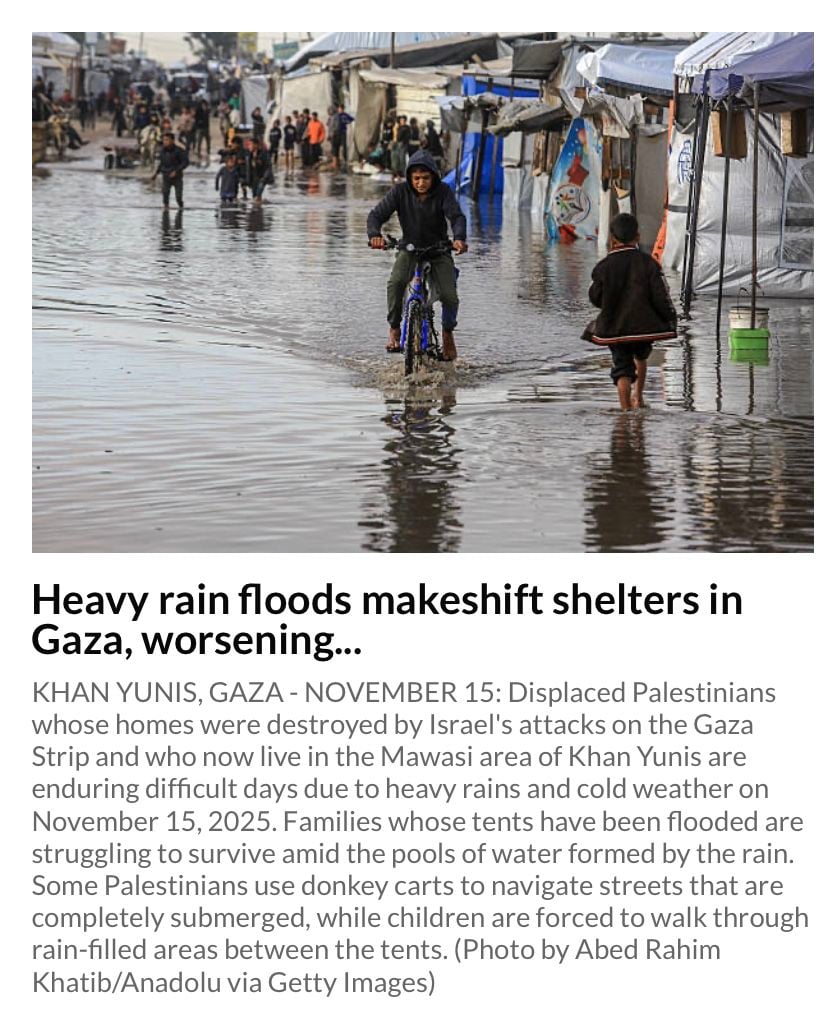
Above: A child rides through a shallow puddle while the surrounding area remains dry. The caption mentions cold weather but the conditions were warm and bright. The scene is selectively framed to exaggerate hardship.
⸻
2.
Forensic Analysis
The photograph positions five unhooded children in a car beside a donkey cart carrying three masked or hooded adult males. The adults conceal their faces. The children face the camera. This contrast creates an engineered emotional dynamic.
The road surface behind both vehicles is dry. Pedestrians stand comfortably on unaffected ground. The supposed flood zone is only a shallow puddle in the immediate foreground.
The photographer uses mid-height framing to compress the spatial depth. A tilt towards the foreground water and away from the dry areas strengthens the suggestion of wider inundation.

Above: Children are placed as the emotional center of the frame while the masked adults avoid visibility. The background shows dry ground, contradicting the idea of extensive flooding.
⸻
3.
Forensic Analysis
A child runs through water in the foreground. Behind him, the horizon is dry. Cars and pedestrians stand entirely on dry ground. The caption again places blame exclusively on Israeli attacks while avoiding any mention of the warm weather or visible dryness.
The photographer uses a slight forward lean and mid-depth focus to keep attention on the splashing foreground. The dry rear zone becomes background blur.

Above: A child runs through a puddle while cars and pedestrians remain on dry ground. The caption stresses hardship but the image shows only a localized patch of water.
⸻
4.
Forensic Analysis
A small child stands in a thin reflective layer of water wearing flip-flops. No adults are visible. The child’s posture is neutral and unhurried, which contradicts the caption’s implication of worsening conditions. Tents in the mid-ground are on dry soil.
The photographer uses a shallow depth of field to render the foreground puddle as more dominant than it is. The dry tent walls and dry ground are present but visually deemphasized.

Above: A child stands in a shallow reflective puddle while tents and paths behind remain dry. The caption implies worsening conditions but the environment shows minimal standing water.
⸻
5.
Forensic Analysis
Children jump and play in a shallow puddle. The water is thin and reflective. Behind them, both pathways and tent walls are dry. No adults appear in frame. The photographer crops tightly to exclude the wider dry area surrounding the scene.
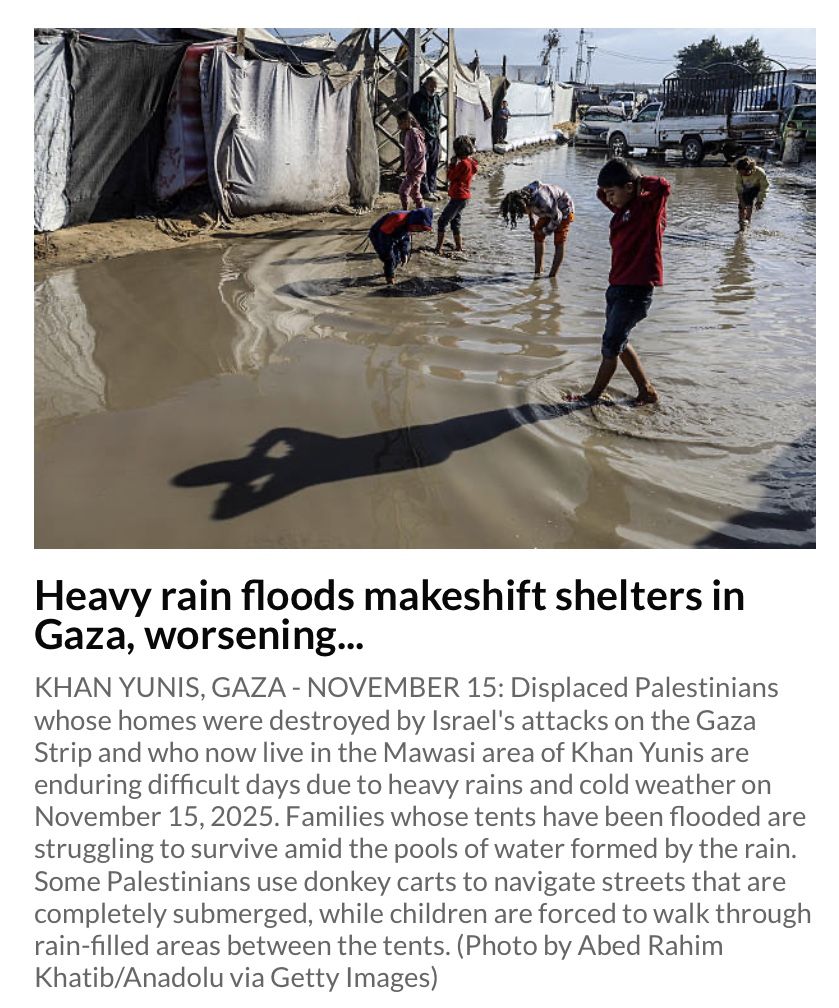
Above: Despite dramatic headlines, this is a group of children playing in a puddle bordered by dry ground. No flooding is present.
⸻
6.
Forensic Analysis
An older man kneels on dry earth, repairing an object while a child stands beside him on entirely dry ground. A narrow puddle sits nearby but does not affect their movement. The photographer avoids showing the broad dry expanse surrounding them by choosing a compressed angle and tight frame.
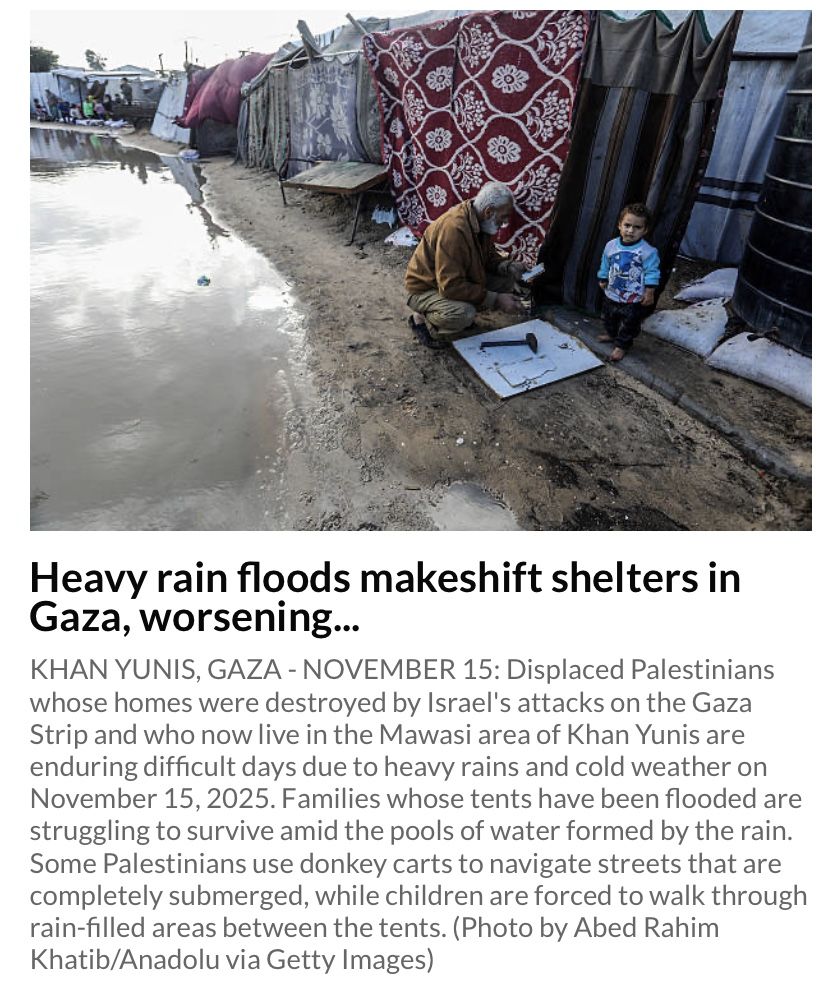
Above: The caption refers to worsening rains, yet both subjects are on dry ground. This is an ordinary routine, not a flood impact.
⸻
7.
Forensic Analysis
A line of children walks beside a shallow puddle. Multiple dry areas and parked vehicles sit behind them. The sunlight casts strong shadows, contradicting the claim of cold or severe weather. The photographer shoots from a mid-height to keep the puddle dominant, while the dryness behind is visible only at the edge of the frame.

Above: Children walk beside a shallow puddle while large dry areas and vehicles behind them show no flooding. The emotional message does not match environmental reality.
⸻
8.
Forensic Analysis
A boy carries his shoes and steps into a shallow reflective puddle. Older boys follow behind him. The puddle is thin and localized. Tents, crates and fabric structures behind them are fully dry. The photographer tilts the frame to maintain the waterline as the central visual element while visually minimizing the surrounding dryness.
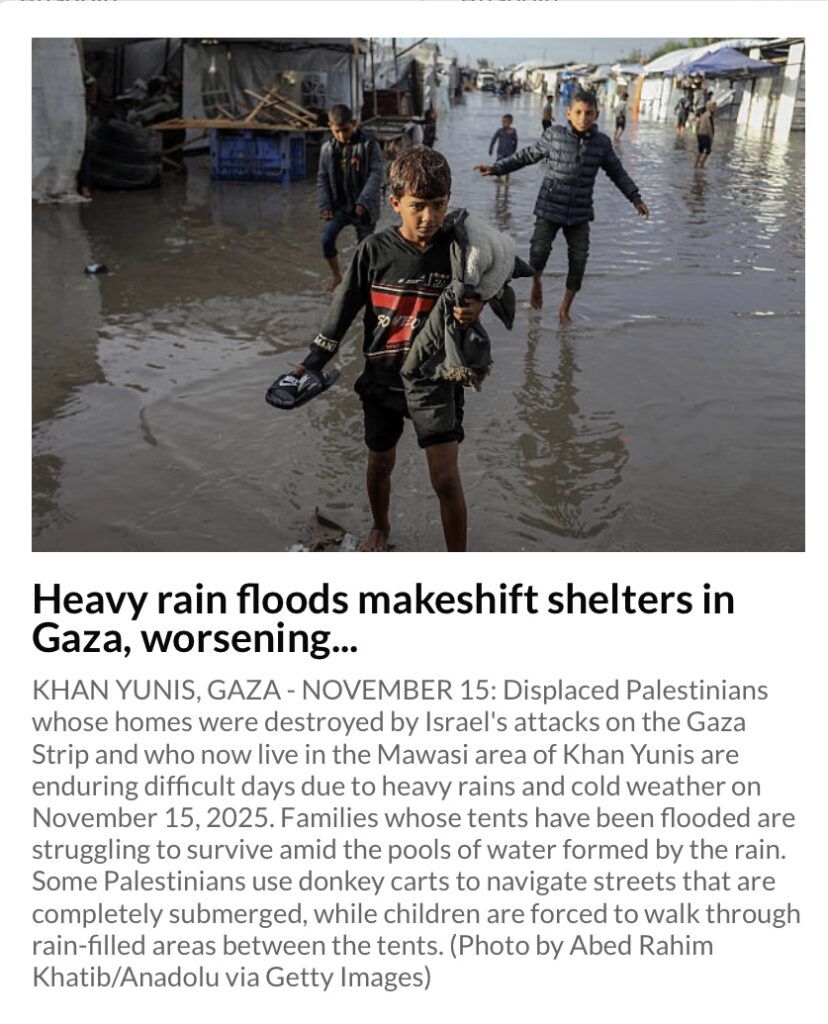
Above: Children walk through a thin reflective puddle in bright sun. The tents and crates behind them are dry, indicating that the scene is staged for emotional effect rather than documenting widespread flooding.
Conclusion: A Visual Narrative Engineered for Sympathy
Across all eight images, the pattern is consistent. Every image features a child. Every image isolates a shallow puddle. Every image conceals dry ground nearby. Every caption emphasizes hardship while omitting contradictory visual facts. Every photograph was taken by a photographer who entered Israel with Hamas on October 7.
None of this is accidental.
This is not neutral documentation.
It is engineered imagery designed to evoke sympathy, imply collapse, and embed blame.
The subterranean tunnel network and its impact on Gaza’s drainage systems are never mentioned. The warm weather conditions are never mentioned. The dry surroundings are never mentioned. The photographer’s October 7 infiltration is never mentioned.
This investigation shows how a two-day rain event – the same type that causes brief puddling across Israeli cities each year – was transformed into a global symbol of suffering.
The narrative was constructed.
The images were selected.
The framing was deliberate.
The emotional message was engineered.
Liked this article? Follow HonestReporting on Twitter, Facebook, Instagram and TikTok to see even more posts and videos debunking news bias and smears, as well as other content explaining what’s really going on in Israel and the region. Get updates direct to your phone. Join our WhatsApp and Telegram channels!
